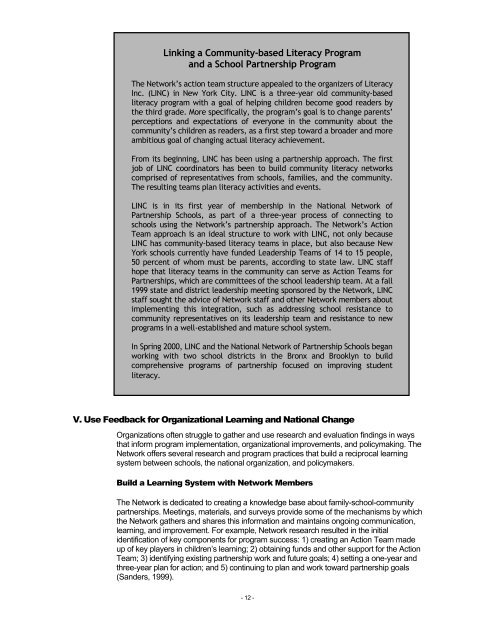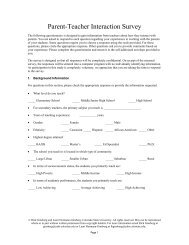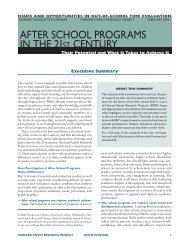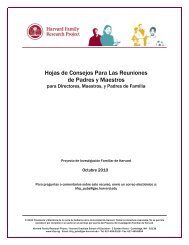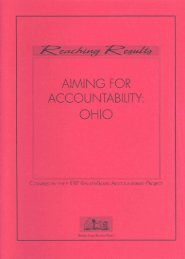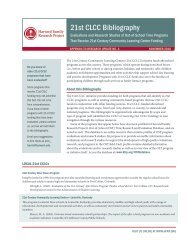Download a PDF of this case study - Harvard Family Research Project
Download a PDF of this case study - Harvard Family Research Project
Download a PDF of this case study - Harvard Family Research Project
Create successful ePaper yourself
Turn your PDF publications into a flip-book with our unique Google optimized e-Paper software.
Linking a Community-based Literacy Program<br />
and a School Partnership Program<br />
The Network’s action team structure appealed to the organizers <strong>of</strong> Literacy<br />
Inc. (LINC) in New York City. LINC is a three-year old community-based<br />
literacy program with a goal <strong>of</strong> helping children become good readers by<br />
the third grade. More specifically, the program’s goal is to change parents’<br />
perceptions and expectations <strong>of</strong> everyone in the community about the<br />
community’s children as readers, as a first step toward a broader and more<br />
ambitious goal <strong>of</strong> changing actual literacy achievement.<br />
From its beginning, LINC has been using a partnership approach. The first<br />
job <strong>of</strong> LINC coordinators has been to build community literacy networks<br />
comprised <strong>of</strong> representatives from schools, families, and the community.<br />
The resulting teams plan literacy activities and events.<br />
LINC is in its first year <strong>of</strong> membership in the National Network <strong>of</strong><br />
Partnership Schools, as part <strong>of</strong> a three-year process <strong>of</strong> connecting to<br />
schools using the Network’s partnership approach. The Network’s Action<br />
Team approach is an ideal structure to work with LINC, not only because<br />
LINC has community-based literacy teams in place, but also because New<br />
York schools currently have funded Leadership Teams <strong>of</strong> 14 to 15 people,<br />
50 percent <strong>of</strong> whom must be parents, according to state law. LINC staff<br />
hope that literacy teams in the community can serve as Action Teams for<br />
Partnerships, which are committees <strong>of</strong> the school leadership team. At a fall<br />
1999 state and district leadership meeting sponsored by the Network, LINC<br />
staff sought the advice <strong>of</strong> Network staff and other Network members about<br />
implementing <strong>this</strong> integration, such as addressing school resistance to<br />
community representatives on its leadership team and resistance to new<br />
programs in a well-established and mature school system.<br />
In Spring 2000, LINC and the National Network <strong>of</strong> Partnership Schools began<br />
working with two school districts in the Bronx and Brooklyn to build<br />
comprehensive programs <strong>of</strong> partnership focused on improving student<br />
literacy.<br />
V. Use Feedback for Organizational Learning and National Change<br />
Organizations <strong>of</strong>ten struggle to gather and use research and evaluation findings in ways<br />
that inform program implementation, organizational improvements, and policymaking. The<br />
Network <strong>of</strong>fers several research and program practices that build a reciprocal learning<br />
system between schools, the national organization, and policymakers.<br />
Build a Learning System with Network Members<br />
The Network is dedicated to creating a knowledge base about family-school-community<br />
partnerships. Meetings, materials, and surveys provide some <strong>of</strong> the mechanisms by which<br />
the Network gathers and shares <strong>this</strong> information and maintains ongoing communication,<br />
learning, and improvement. For example, Network research resulted in the initial<br />
identification <strong>of</strong> key components for program success: 1) creating an Action Team made<br />
up <strong>of</strong> key players in children’s learning; 2) obtaining funds and other support for the Action<br />
Team; 3) identifying existing partnership work and future goals; 4) setting a one-year and<br />
three-year plan for action; and 5) continuing to plan and work toward partnership goals<br />
(Sanders, 1999).<br />
- 12 -


